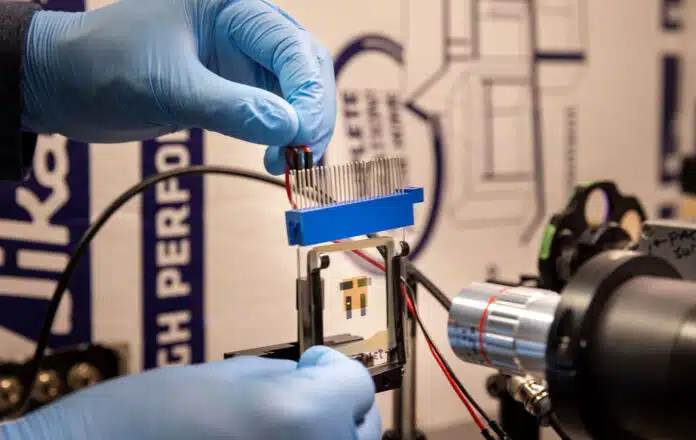
By Ashwini Sakharkar 19 Sep, 2024
Collected at: https://www.techexplorist.com/oled-replace-bulky-night-vision-goggles-lightweight-glasses/89961/
Organic light-emitting diodes (OLEDs) stand as one of the most successful organic electronic devices to date. They hold a dominant position in the mobile display market and are rapidly making inroads into various lighting, automotive, and wearable device applications.
Now, University of Michigan researchers have developed a new type of OLED (organic light emitting diode) that has the potential to replace bulky night vision goggles with lightweight glasses. This advancement could make night vision technology more affordable and practical for extended use.
Additionally, the memory effect in the OLEDs could pave the way for computer vision systems capable of both sensing and interpreting incoming light signals and images.
The current night vision systems rely on image intensifiers that transform near-infrared light into electrons, which then accelerate through a vacuum into a thin disc containing hundreds of tiny channels. As they pass through and collide with the channel walls, the electrons release thousands of additional electrons and go on to strike a phosphor screen, which converts them into visible light. This process amplifies the incoming light by 10,000 times, enabling the wearer to see at night.
The newly developed OLED device also converts near-infrared light into visible light and amplifies it more than 100 times, without the weight, high voltage, and cumbersome vacuum layer required for traditional image intensifiers. The researchers believe that optimizing the design of the device can lead to even higher amplification.
“One of the most attractive features of this new approach is that it amplifies light within a thin film stack that is less than a micron thick. That’s much thinner than a strand of hair, which is about 50 microns thick,” said Chris Giebink, U-M professor of electrical and computer engineering and physics and corresponding author of the study recently published in Nature Photonics.
The device’s operation at a lower voltage compared to a traditional image intensifier holds the promise of significantly reducing power consumption and extending battery life. It achieves this through the integration of a photon-absorbing layer, converting infrared light into electrons, and a five-layer OLED stack, where electrons are transformed into visible light photons. The goal is to generate five photons for each electron passing through the OLED stack.

The photons emitted are not only observed by the user’s eye, but some are also reabsorbed, generating additional electrons that create a positive feedback loop within the OLED. This amplifies the output light significantly compared to the input light. In the past, OLEDs could only convert near-infrared light to visible light without any gain, meaning one input photon resulted in one output photon.
“This marks the first demonstration of high photon gain in a thin film device,” said Raju Lampande, U-M postdoctoral research fellow in electrical and computer engineering and lead author of the study.
Additionally, the device displays a memory behavior called hysteresis, where its light output at a given moment is influenced by the intensity and duration of past input illumination. This feature could have applications in computer vision.
“Normally, when you illuminate an upconversion OLED, it starts outputting light, and when you turn off the illumination, it stops outputting light. This device can get stuck on and remember things over time, which is unusual,” Giebink said.
The unique memory behavior of the OLEDs presents challenges for night vision applications, but it also opens up new possibilities for image processing that mimics the human visual system. This technology allows for the interpretation and classification of input images without requiring separate computing units, similar to how biological neurons process signals.
The device was created using readily available materials and methods used in OLED manufacturing, making it cost-effective and scalable for future applications. This work was conducted in collaboration with OLEDWorks and RTX, and the technology is currently patent-pending by OLEDWorks and Penn State University.
Journal reference:
- Raju Lampande, Jon-Paul S. DesOrmeaux, Adrian Pizano, Jonathon R. Schrecengost, Robert Cawthorn, Hunter Bowman, Alex Grede, Urcan Guler, John W. Hamer & Noel C. Giebink. Positive-feedback organic light-emitting diodes and upconverters. Nature Photonics, 2024; DOI: 10.1038/s41566-024-01520-0

Leave a Reply